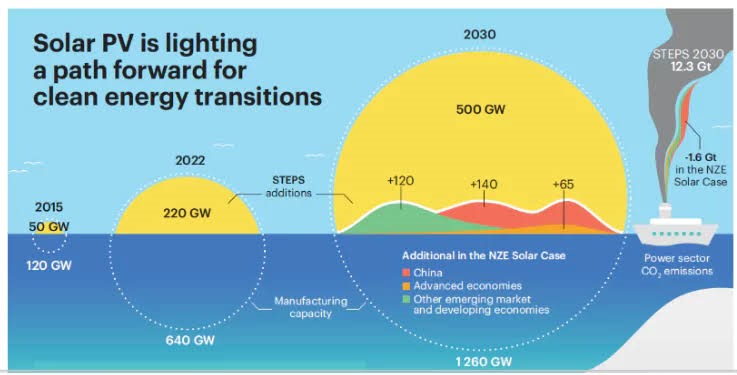
World Energy Outlook-2023 Report

27.10.2023
World Energy Outlook-2023 Report , Daily Current Affairs , RACE IAS : Best IAS Coaching in Luucknow
|
For Prelims: World Energy Outlook Report 2023,Important points,Major reports released by IEA For mains GS paper 3:India in the World Energy Outlook Report 2023,Suggestion,Initiatives taken by India to reduce carbon emissions,International Energy Agency,Major areas of work of the International Energy Agency |
Why in the news?
Recently the International Energy Agency (IEA) released its World Energy Outlook 2023 report.
Important points:
- The share of fossil fuels in global energy supply is projected to decline from about 80% to 73% by 2030.
- Global energy-related carbon dioxide (CO2) emissions will peak by 2025.
World Energy Outlook Report 2023:
- The report highlights the sweeping changes expected to take place in the global energy sector by the end of this decade.
- According to the World Energy Outlook report, the share of renewable energy in the world will reach 50 percent by 2030 from the current 30 percent.
- By 2030 there will be approximately 10 times more electric cars on roads worldwide.
- Investment in new offshore wind projects will triple by 2030, according to the World Energy Outlook report.
- The demand for fossil fuels i.e. oil, gas and coal will be at its peak in 2030, after which the demand will start decreasing.
- However, it is important to note that coal is the only fossil fuel projected to decline over the next decade under the International Energy Agency's announced policy scenarios.
- Global coal consumption is projected to decline 13.5% by 2030, but natural gas and oil consumption are both projected to increase.
India in the World Energy Outlook Report 2023:
- The growth in energy demand in India over the next three decades will be the highest compared to any country or region in the world.
- Electricity consumption to run home air conditioners alone is projected to increase ninefold by 2050.
- By 2030, India's industry will emit 30% less CO2 (carbon dioxide), and each kilometer driven by a passenger car on Indian roads will emit 25% less CO2.
- As part of its energy development, India is entering a dynamic new phase marked by long-term net zero emissions ambitions, increased regulatory sophistication, a focus on clean energy deployment, and the establishment of domestic clean energy technology supply chains.
- Based on current policy scenarios, India's energy supply is projected to increase from 42 exajoules (EJ) in 2022 to 53.7 EJ in 2030 and 73 EJ in 2050. Similarly, oil demand is projected to increase from 52 lakh barrels per day (bpd) in 2022 to 68 lakh bpd in 2030 and 78 lakh bpd in 2050.
Suggestion:
- Encouraging the transition to cleaner and more sustainable energy sources such as renewable energy (solar, wind, hydropower) to reduce greenhouse gas emissions and combat climate change.
- Increase investment in renewable energy infrastructure, including solar and wind power projects, to meet growing energy demand and reduce dependence on fossil fuels.
- Promote electrification of the transport sector, including development of electric vehicles (EVs) and necessary charging infrastructure.
- Implementation of carbon pricing mechanisms, such as carbon taxes or cap-and-trade systems, to incentivize emissions reduction efforts.
- To engage in international partnerships and collaborations to access technology, expertise and financing for sustainable energy projects.
- Implementing measures to address air pollution, including stricter emission standards for vehicles and industries, to improve public health and reduce environmental damage.
Initiatives taken by India to reduce carbon emissions:
- International Solar Alliance (ISA):
- One Sun, One World, One Grid project with the United Kingdom:
- Leadership Group for Industry Transformation (LeadIT):
- Accelerating the e-mobility transition with plans to accelerate adoption and manufacturing of hybrid and electric vehicles.
- Mission LiFE: Mission LiFE is a global people's movement led by India that aims to encourage individual and collective action to protect and conserve the environment.
About International Energy Agency (IEA):
- The International Energy Agency was established following the 1973–1974 oil crisis to help its members respond to major disruptions in oil supplies.
- The International Energy Agency was established in Paris (France) in 1974.
- The International Energy Agency is an autonomous organization that works with its 30 member countries and 8 partner countries to ensure reliable, affordable and clean energy globally.
- IEA mainly focuses on energy policies, including economic development, energy security and environmental protection, etc. These policies are also known as the ‘3Es’ of the International Energy Agency.
- IEA's International Energy Agency Clean Coal Center is leading important work in providing independent information and analysis on making coal a clean source of energy consistent with the Sustainable Development Goals.
Major areas of work of the International Energy Agency:
- Energy security: Promoting diversity, efficiency and resilience across all energy sectors.
- Economic Development: Ensuring stable supplies of energy to IEA member countries and promoting free markets to promote economic growth and eliminate energy poverty.
- Environmental awareness: increasing international knowledge about options to combat climate change.
- Global engagement: Working closely with non-member countries, particularly major producers and consumers, to find solutions to shared energy and environmental concerns.
Major reports released by:
- World Energy Outlook Report.
- World Energy Investment Report.
- Energy Technology Perspectives.
- India Energy Outlook Report.
- World Energy Statistics.
- World Energy Balances.
Source: Times of India